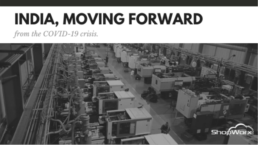Why IOT Matters?
If you think that the internet has changed your life, think again. The Internet of Things is about to change it all over again!
- Brendan O’Brian
IOT & WHY YOU SHOULD GO FOR IT
Internet of Things (IoT) is about creating a robust network of physical objects connected online for real-time monitoring. The sole purpose of online connectivity is to remotely monitor an object’s status, analyze collected data, & take the right decision to boost productivity targets. IoT relies on smart microsensors compatible with any machine that ensure online visibility. Its popularity can be judged from the fact that there are more than 30 billion IoT devices around the world in 2020. Every second 127 IoT devices are getting added online! In 2025, this figure is estimated to be 80 Billion.
The average growth per year for IoT is 33%, that’s a mammoth growth!! Talking about business growth in 2019, the total IoT market was 465 Billion USD, which will grow to 1.5 Trillion USD in 2030.
World markets are raving to adopt IoT due to its ease of use, cost savings, production efficiency, and compatibility with the latest technologies like ML, AI, Blockchain, and Microsoft Azure.
DIGITAL TRANSFORMATION IN MANUFACTURING
The state of manufacturing is continuously changing due to the dynamic forces of supply-demand, technological, economic, environmental, and policy changes. The best practices implemented last year might not work this year. This is clearly evident during covid-19. Closed factories, loss of wages, workers migration, absent manpower, and huge business loss were the main reasons that led to the underachievement of production and millions of Dollars of business loss. As you can see, digital transformation in manufacturing is not only about automating the manufacturing shop floor. It’s about changing a business mindset to solve crippling age-old problems transparently and effectively. We bring you ShopWorx, a popular IoT solution that works on solving your manufacturing woes. ShopWorx helps in the smooth conversion of traditional factories into smart factories. You get smart data management & decision making at the palm of your hand.
Our solutions offer in-depth plan to perfect the Overall Equipment Effectiveness (OEE) score. This is done through our unique production monitoring and predictive maintenance systems.
PRODUCTION MONITORING SYSTEM
IoT in industry 4.0 is here to surprise you.
Wait no more for
- Traditional methods of data collection
- Reasons behind production delay
- Puzzled over multiple errors
- Never-ending wait for action Plan
ShopWorx offers real-time production monitoring of machines with their live online status.
The production manager sitting at a remote location checks in-depth machine performances on the manufacturing shop floor starting from
- Working status of machines (Uptime/Downtime)
- Tracking real-time production
- Real time machine usage analysis
All this is done through the seamless connectivity of devices. Sourced data is monitored, analyzed using graphics, pie charts, SMS, and email alert systems.
Sounds exciting for business? Yes, it is!!
IOT PREDICTIVE MAINTENANCE
You would be glad to know that IoT can successfully tap over the unwanted noise coming from industrial equipment to understand their health. To avoid unexpected breakdown and outages, IoT predictive maintenance enables real-time health analysis of noisy equipment. One can ask about the business problems that predictive maintenance can solve.
It can be
- Employee dependence for manual inspection of equipment
- Calling the authorized service personnel for equipment maintenance
- Sudden equipment failure, hitting production efficiency
- Absence of visibility on the health of equipment
IoT helps a lot in chalking out a solution like
- Raising automatic tickets for maintenance
- Using a vibration sensor to detect equipment noise
- Feed sensor data to Microsoft Azure (Cloud Computing service)
- Predict possible problems based on sensor data
Benefits of IoT predictive maintenance
- Automated dispatch of service
- High uptime of equipment
You would be excited to know that predictive maintenance has saved 5 – 7 Billion USD for Oil & gas, healthcare & transportation sectors.
Industrial IoT Applications
According to PWC reports, 90% of manufacturers believe that they will get long term benefits from digitizing the production process.
Here are the Industrial IOT applications:
- Increasing utilization rates of industrial machines
- Ensuring real-time production visibility
- Continuous monitoring of variables affecting productivity
- Monitoring environmental conditions in industrial space
- Automated monitoring of inventories
- Optimization of Supply chain
- Plant safety improvement
- Quality control
IOT IN MANUFACTURING
There are number of successful implementations of IoT in manufacturing industry.
- Digital Twins: It represents the digital replica of similar products.
- Smart Pumping: IoT devices turn off pumps according to pre-defined metrics.
- Self dependent systems: Creates self healing automated systems to regain control on downtime.
We at ShopWorx have some of the biggest success stories of implementing IoT in manufacturing.
We are only a call away to boost your business productivity & efficiency Contact us now.
CONCLUSION
IoT technology adoptability and connectivity is expanding at a rapid rate. It has vast potential to boost the availability of information and transform the way manufacturing is done. The world is waking up to the new industrial revolution. We should make sure, that we are not left far behind in the transformation.
Plastic component manufacturers deriving benefits from Industry 4.0
Pune, India 20 October 2020
Digital transformations in manufacturing are being witnessed and with the advent of Industry 4.0, plastic component manufacturers may even produce small batch sizes’ economically.
The convergence of Industry 4.0 and the industrial Internet of Things (IIOT) has directed smart factories’ development. Today, the cyber-physical systems leverage IIoT technologies to monitor physical manufacturing processes and build virtual copies of the physical world to perform analyses and automate decision-making. To execute these extensive processes, enormous data gets generated, which has pressed upon the need to move towards cloud management.
With its sheer effectiveness to improve competitiveness and productivity by leaps and bounds, plastic manufacturers understand the need to embrace Industry 4.0.
Plastic manufacturing w.r.t Industrial revolution 4.0 signals an era of better visibility and improved performance of a plant. It also assists in the interlinking of internal processes and departments of a plastic component manufacturing unit i.e. overall supply chain management.
What are the immediate benefits of 4.0 on plastic processing?
If you’re looking to learn about significant opportunities that Industry 4.0 may bring for the plastic component units is as follows:
- Customized parts
- Quick production of individualized parts
- Shortening of development time
- Reducing setup and startup times
These core capabilities altogether equip the manufacturers with an opportunity to produce batch size 1 at the same cost as mass production. Let’s now learn the in-depth benefits of adopting Industry 4.0.
Benefits that plastic component manufacturers derive
1) Production Monitoring & real-time Insights
Introduction to Industry 4.0 assists manufacturers in creating a cyber-physical environment by converging operational technology (OT) and information technology (IT).
Intuitive cloud-based software replacing manual inventory control effectively assists in automated inventory monitoring, conclusively improving overall plant performance. With the implementation of such modern systems, the plant throughput can also be monitored conveniently. These software and tools are designed to automatically keep track of inventory purchase and optimization of the processes. Also, if any connected tool demands repurchase or repair; the cyber-physical system would send a notification automatically for the same.
Implementation of such systems not only eliminates repeatability and human errors but also improves production monitoring. With these systems installed at their plant, manufacturers can monitor an extensive range of parameters, including downtime quantities of raw materials, production errors, repair time, and much more remotely!
2) Maximum Productivity
Embracing Industry 4.0, along with digital manufacturing, comes with a myriad of benefits for plastic manufacturers, including operational performance, agility, and flexibility.
In any plastic manufacturing unit, machine uptime is crucial to achieving maximum productivity. In case any machine breaks down, the output would slump. The traditional process of maintaining machines includes scheduled maintenance by third-party vendors, but they’re prone to human errors and are NOT effective in predicting production halting issues.
Industrial IOT applications make condition-based and predictive maintenance possible. Further, IOT predictive maintenance benefits in monitoring machine health in real-time. Multiple sensors installed help in identifying any specific trend or issue alerts before the failure of equipment. This will help in reducing any bottleneck effect during the production process. Thereby increasing plant productivity.
3) Smart IT Integration
Integrating ‘Smartness’ in a plastic component manufacturing unit will make it more connected, agile, transparent, optimized, and proactive.
Getting a Smart factory lets a manufacturer gain a flexible system that’s capable of self-optimizing performance across the plant. Moreover, it can self adapt to newer conditions in real-time to run the entire production process.
Not to forget, smart IT integration will help ease the overall equipment effectiveness (OEE) reporting by displaying real-time KPIs on the screen to spot any irregularities in the system.
4) Digital Transformation
Industry 4.0 serves manufacturers with an opportunity to empower employees, optimize production, transform products, connect consumers, and add customized experiences.
It is not just plastic manufacturing units, but the digital transformation has become critical for the success of any other business in the production field. Predictive maintenance with these cyber-physical systems will ensure manufacturers have a future within the industry.
Technologies such as IoT, machine learning, advanced analytics, and cloud computing make significant transformations in the manufacturing industry. Moreover, they’re reliable and can be installed at lower costs in companies of all sizes.
So, is there any reason left not to consider embracing cyber-physical systems as an option for your plastic component manufacturing plant? We don’t think so.
Conclusion
Leveraging these cyber-physical systems (CPS) and other modern technology-based tools or software to boost any plastic manufacturing plants’ efficiency and productivity is no longer an advantage, but a necessity.
Without the introduction of Industry 4.0, traditional plastic manufacturing plants may struggle in mitigating their productiveness and monitoring problems. Production monitoring systems and IOT in manufacturing can optimize the plants to develop a responsive framework that can serve in boosting overall profitability and productivity.
Marketing Executive
Job Description:
We are looking for a talented Marketing Executive to undertake marketing projects for the benefit of our company. You will organize creative campaigns and promotional events that can make a difference for our company’s success according to trends and customer requirements.
The ideal candidate will be passionate for the “art” of marketing and will have an abundance of ideas for building efficient strategies. He/she must bring forth a strong arsenal of techniques and methods to promote our products, services and public image.
The goal is to reach out to the market and cultivate the customer’s interest in our products and services in ways that strengthen our reputation and facilitate our continuous growth.
Responsibilities:
- Conceive and develop efficient and intuitive marketing strategies
- Organize and oversee advertising/communication campaigns (social media, TV etc.), exhibitions and promotional events
- Conduct market research and analysis to evaluate trends, brand awareness and competition ventures
- Initiate and control surveys to assess customer requirements and dedication
- Write copy for diverse marketing distributions (brochures, press releases, website material etc.)
- Maintain relationships with media vendors and publishers to ensure collaboration in promotional activities
- Monitor progress of campaigns using various metrics and submit reports of performance
- Collaborate with managers in preparing budgets and monitoring expenses
Skills:
- Proven experience as marketing executive or similar role
- Good understanding of market research techniques, data analysis and statistics methods
- Thorough knowledge of strategic planning principles and marketing best practices
- Proficient in MS Office and marketing software (e.g. CRM)
- Familiarity with social media and web analytics (e.g. Google Analytics)
- Excellent communication and people skills
- Strong organizational and time-management abilities
- Creativity and commercial awareness
- BBA/MBA in marketing, business administration or relevant discipline
The harsh realities of COVID-19 on Manufacturing: Moving to a more digitized India
Pune, India 11 June 2020
Manufacturing in India contributes to nearly 15% of GDP as we are home to some of the largest manufacturers cross-domain. From Cement manufacturing to the likes of Tata Motors, Asian Paints and Amul, spread across the country - we produce everything domestically, from electronics to automobiles, and from pharmaceuticals to durable goods.
We are not just capable of meeting domestic demand, but also international.
India has rightly been coined as a manufacturing powerhouse, resourceful and ready for the ramp-up to Industrialization 4.0.
How will the COVID-19 crisis change the way manufacturing occurs and takes place at scale?
In 2017, India took over France to become the sixth-largest economy in the world. India is predicted to be a $1TR manufacturing economy by 2025 owing to the large domestic markets, significant FDI’s and a large and growing populace of semi-skilled labour. According to IBEF, around 24 per cent of India’s total employed population was working in the industrial sector in 2018.
Manufacturing in India is an industry that is supported by the Government and public policy. The goal, to enhance output and productivity. From upskilling labour to ‘Make in India’ that was launched in 2014, till ‘Vocal for Local’ that is being campaigned in 2020 - India is a lucrative market for domestic and multinational manufacturers.
All of the efforts from the Government and its people are working towards stimulating growth and GDP. India as a global manufacturing hub is no longer a dream.
COVID-19: India’s biggest hit in 15 years
As COVID19 ensued, headlines such as “Manufacturing at a halt” and “Manufacturing factories lie empty” were seen plastered on all news channels. It’s true and yet shell shocking that the IHS Markit India Manufacturing Purchasing Managers’ Index (PMI) fell to 27.4 in April, from 51.8 in March, which was the steepest decline India has seen since the last 15 years.
While India and the world were undergoing the wrath of this communicable disease, there were some lessons to learn and take away. India was not prepared for this economic downturn caused by a virus.
On the brighter side, India has strength in numbers and capability. We outdid ourselves within the realm of PPE kits. An essential item for everyone on the frontlines, battling COVID-19 and fighting to save lives.
India went from manufacturing 0 to 4.5L PPE kits in a day, in just 2 months, with Bengaluru coming out as the front runner of production.
The two things that were evident from the global crisis for the manufacturing industry were:
- The need to diversify manufacturing hubs as the danger of centralizing within China were felt. Some of the contenders are India, Vietnam, Bangladesh and Ethiopia.
- Digitization of processes and workflows could’ve led us to not a complete shutdown, but a slowdown. Had this been in place, a certain level of manufacturing could’ve taken place with minimal human contact
- As the world trust shifts away from China, the supply chain and manufacturing of essentials might take place/go via other countries
The smart factory with digitization
As the world changes day by day, India must evolve and adapt.
If India is to compete on a global scale, it is imperative we take into account the benefits of digitization as we walk towards Industrialization 4.0. Digitizing brings in not just efficiency but also volume. As markets become more dynamic and competitive, smart factories, IoT and even robotic process management will be the need of the hour.
What is a ‘smart factory’?
Smart factories are paperless factories that have data coming from all sub-systems and integrated into one central system. Smart factories can be built with the help of technologies like ShopWorx who is offering apps for advanced production planning, real-time monitoring and alerts for production / processes failures, preventive & predictive maintenance, advanced traceability and more to ensure good production quality and optimized production efficiency.
From digitizing shop floors with technology, to digitizing distribution channels till digitizing supply and demand - companies must use the technology available if they want to compete. After all, India’s sweet spot lies within the power of digitization combined with the low cost of labour to create a competitive advantage for us.
The curse to this blessing lies within the lack of data. Currently, which is traditionally stored and used is inaccessible. This data is often not available in real-time. Data has the power to give backing to qualitative and quantitative information which has the potential to bridge the gap between company goals and India’s goals.
In the instance of ShopWorx, enabled real-time data from the factories, accessible remotely even when away from the factory. This has allowed a much more in-depth analysis of the factory floor, ensuring it’s well managed and prepared for run time. With ShopWorx, we’ve seen a 8-10% month on month OEE improvement and a 92% reduction in excess/unplanned downtime in factories we service.
With ShopWorx we enable Indian manufacturing factories to have a heightened awareness of their factory floor, through data and smart algorithms.
Post-COVID India: Digitized
The Coronavirus has over time highlighted various critical gaps in the manufacturing sector. It has shown us the importance of digitization and the importance of technology as a supplement to success. Therefore, it is fair to state that the COVID-19 crisis has acted as a catalyst to the transition to manufacturing digitization globally.
Companies have now realised for business continuity to ensue, it is imperative that they take on digitization as an initiative. The size of the manufacturing plant does not matter here. COVID-19 had the power to make everything stop in its tracks.
Some of the reasons why digitization must be of top priority as we recover from the damages:
- Data as a business bloodline: In a post-Corona era data its usage was taken with a pinch of salt. Now, data is going to be a key factor in decision making for manufacturing. It can be large scale data of global manufacturing trends, or macro level at the factory in terms of efficiency. How we collect, store, analyze and data will change manufacturing as an industry, for the greater good.
- A remote/decentralized workforce: The COVID crisis has forced everyone to embrace ‘work from home’ as a part of their jobs. For manufacturing, unfortunately, that meant a complete shutdown; now, business people are going to focus on the safety element as an answer to ‘why digitization’. If a process can be done with lesser human interaction, it should.
- A shift to online first: In an online first set up, it is extremely tedious to have physical records and business workings. It is almost essential that digitization takes place so that records are accessible when offsite, and online behaviours and activities are tracked
As India prepares for recovery, Prime Minister Narendra Modi pledged total spending of Rs 20 lakh crore as a stimulus to the economy, especially for industries and MSME’s along with working-class and middle-class citizens. The package is aimed at helping MSME’s fight the liquidity crunch and has available emergency credit and accessible loans.
According to an Economic Times report, in the beginning of June, Public Sector Banks sanctioned loans worth Rs 17,705.64 crore under the 100% Emergency Credit Line Guarantee Scheme starting June 1. This is targeted towards MSME’s who were hit hard due to the COVID-19 lockdown.
The overarching goal of this 20L CR package would be to help Indian manufacturers resume business, reignite supply chains and be able to substitute imported items with local ones.
Challenges of a digitized India post-COVID 19
India is indeed on the path of digitization, and COVID-19 provided a unique opportunity for us to accelerate acceptance and penetration of digital interfaces.
However, India faces two challenges to become ‘truly digitized’
- The rural-urban digital divide
- Dearth of cost-effective and reliable internet (data/broadband)
India is a country of 1.3B people in total, out of which a mere 504 million were recorded as active internet users according to the Hindustan Times. Moreover, India faces a rural-urban split in mobile users. Data suggests that for the first time, in 2019, rural mobile users outnumbered urban, with a 10% margin, according to a study by YourStory.
With the cost of 4G data in India being the cheapest worldwide, at just $0.26 per 1GB according to Mary Meeker’s Internet Trends Report, we should’ve seen a higher 4G penetration, but that number stands at 88%.
When the data was further dug into, ⅔ of India’s Internet users were between 12-29 according to IAMAI. By just looking at the numbers, you can see that the working population amongst this is around the age bracket of 23-29, which further pulls down the number.
Rural India faces a multi-dimensional challenge with data - their main issues lie within connectivity, quality of service and affordability.
With the COVID-19 situation, reports by Ericsson ConsumerLab showed that the average time spent on 4G went up by 2.2 hours per day during COVID-19. This resulted in a 20-50% increase in mobile usage for a quarter of Indian consumers during the period.
Adjusting to change in a post-COVID world:
Manufacturing has taken a deep and hard hit due to the COVID crisis, as we have seen. Everything was at standstill for 2-3 weeks, only essentials were in service. India battled with the COVID situation bravely, and is slowly coming out of the dark side.
Companies like ShopWorx, amongst others have now started using the ‘Netflix Subscription’ model for their businesses. This is a win-win for both the company and the end user.
Pay as you go, is a simple concept to lower upfront costs, and gather revenue over a larger time span.
This was also done to aid manufacturing to get back on their feet, steadily and without too much debt/struggle.
India is fighting the Corona epidemic, together, as one.
Conclusion
In conclusion, I leave you with this quote from mark Mobius, founder of Mobius Capital Partners and the father of emerging markets, “The sectors in India that have already moved into digital transformation of their business models will do better in recovery,” he said.
The Government reforms are working in the right direction for its citizens. Opening new avenues of growth, enabling investment opportunities and in turn bumping up production, all to reach the end goal of ensuring labour is occupied meaningfully.
Lastly, and on a positive note Deepak Sood, ASSOCHAM secretary said , “India stands a very good chance to emerge as an alternative to the global manufacturing hubs. The nation has the advantage of a vast pool of highly skilled, skilled and semi-skilled manpower.
A note from the CEO of ShopWorx
I see India as a land of opportunity and potential. I see Indians as a resilient force - we aren’t giving up, and we are fighting this battle, step at a time. We will surely defeat this epidemic, when we all join hands - the Government, policy makers, providers, suppliers and users. It’s highly likely we will come back stronger, more self sufficient and much more digital-first.
More power to India.
Five Use Cases to Take Advantage of IoT in Manufacturing
Pune, India 03 January 2020
The manufacturing industry is getting competitive with each day. Consequently, adopting modern technology is one of the sure-shot ways to achieve unprecedented success. IoT has already created a buzz in the technological space, and with the count of connected devices reaching 200 billion, it's natural for manufacturers to reap its numerous benefits. Connecting several hundred smart devices in an intelligent network might help the manufacturers modify their operations and build enterprise value in the process.
Here are five tips on how you can leverage IoT in manufacturing to benefit your business, starting from customer services and experiences:
- Advancing Customer Experience and Service
In order to make your business profitable, 'customer service' is undoubtedly a critical factor. Modern IoT based technologies such as smart trackers and mobile card readers are used to enhance customer experiences. The latter can be connected to smartphones to handle transactions smoothly, whereas the former can assist the consumer in monitoring their products. Conclusively, technology such as IoT can do wonders in improving customer satisfaction levels.
- Boost Productivity Levels and Improve Proficiency
IoT is a double-edged sword for manufacturers, as it can help them in boosting productivity and competence to assure profitability in business. IoT devices are a perfect medium to assist manufacturing business sectors in accurately evaluating the demands. As a result, they can resourcefully maintain a diversity of production stages by enabling real-time tracking of machinery parts and in-hand raw materials.
- Empowering Device Software Applications
Across all the businesses and industries, smart devices have become firmly more accepted. There will be further growth in device applications in a wide range of business areas supported by IoT, including sectors such as entertainment, education, hospitality, and healthcare.
- Supporting the Business with Data
Data is unquestionably becoming the most effective weapon for every other industry. The automobile industry, for instance, is prolonging more and more towards IoT technologies for enabling vehicles to flawlessly collect and track data to interact with smart city solutions. Such efforts in the automobile industry are possible with IoT and taking the industry in the direction of data-driven business models.
- Analyzing Consumer Behavior
Analyzing the behavior and preferences of customer are essential for achieving success in any business. Leveraging IoT predictive maintenance and other advantages in companies will enable them to track, retrieve, monitor, and analyze data gathered from social networking, video surveillance, the web, and cellular usage. The scenario, as mentioned above, provides essential insights to forecast business trends and consumer preferences. The data collected can be further utilized for accomplishing more healthy engagement levels and offer personalized services or products.
The Future with IoT
IoT solutions are outfitted to create consistent impacts in the domain of each business or its niche. The adoption of IoT solutions may bring about huge benefits and profitability for companies.
Compared to other emerging technologies, IoT has reached the top of demanded expectations. Though IoT can provide great value, companies are needed to prevail over some notable challenges such as data and data management issues, lack of interlinked technologies, and privacy issues.
Front End Web Developer
Job Description:
We are looking for an expert JavaScript developer who is highly skilled with Vue.js. Your primary focus will be developing user-facing web applications and components. You’ll implement them with the Vue.js framework, following generally accepted practices and workflows. You will ensure that you produce robust, secure, modular, and maintainable code. You will coordinate with other team members, including back-end developers and UX/UI designers. Your commitment to team collaboration, perfect communication, and a quality product is crucial.
Responsibilities:
- Developing user-facing applications using Vue.js
- Building modular and reusable components and libraries
- Optimizing your application for performance
- Implementing automated testing integrated into development and maintenance workflows
- Staying up-to-date with all recent developments in the JavaScript and Vue.js space
- Keeping an eye on security updates and issues found with Vue.js and all project dependencies
- Proposing any upgrades and updates necessary for keeping up with modern security and development best practices
Skills:
- Highly proficient with the JavaScript language and its modern ES6+ syntax and features
- Highly proficient with Vue.js framework and its core principles such as components, reactivity, and the virtual DOM
- Familiarity with the Vue.js ecosystem, including Vue CLI, Vuex, and Vue Router
- Good understanding of HTML5 and CSS3, including Sass (Vuetify is a plus)
- Knowledge of functional programming and object-oriented programming paradigms
- Ability to write efficient, secure, well-documented, and clean JavaScript code
- Familiarity with automated JavaScript testing, specifically testing frameworks such as Jest or Mocha
- Proficiency with modern development tools, like Lerna, Babel, Webpack, and Git
- Experience with both consuming and designing RESTful APIs
A “How to” Guide for integrating Digital Manufacturing & Industry 4.0 into your shop floor
Pune, India 16 March 2018:- Outlook Business reported on how Entrib’s flagship product – ShopWorx has managed to integrate Industry 4.0 with Digital Manufacturing into the Discrete Manufacturing (Plastics, Press Metals, Automotive) shop floors.
Doing so, it has proved its worth by providing a 4% raise of their Plant’s availability & 30% increase in productivity in this sector.
ShopWorx aims to digitally transform shop floors while providing a smarter way of manufacturing. By providing data monitoring & analytics solutions in Real -Time, it provides features such as:-
• Production Monitoring,
• Utility Consumption Monitoring (Water, Air, Gas, Electricity, Steam),
• Assembly Line Traceability,
• Paint Shop Process & Health Monitoring &
• Maintenance System (Scheduling & Reporting)
The uniqueness of ShopWorx comes with its approach towards developing client-centric, fully customizable & machine agnostic solutions. On asking Kiran Nataraj (CEO) for further elaboration, following were his comments:
“All of ShopWorx developers are motivated to travel to our client’s plants and gained insights of their shop floor. This not only provides a realistic view towards solving key problems through their solutions but encourages them to think innovatively.
For Instance, a developer spent a week figuring out why one of our apps was not being used. He created a QR code-based mobile app that solved key issues on the shop floor avoiding expensive RFID based scanners and providing an innovative solution that encourages usage of mobile phones on the shop floor.”
Entrib Analytics takes a customer-first approach and has integrated more than 1500 machines (Injection & Blow Molding machine, Extrusion machines & Assembly Lines to name a few) to ShopWorx while monitoring and analyzed more than 1 billion products.
“We have added 20+ customers for this year and had a 300% growth in revenue” added Kiran Nataraj.
ShopWorx – Taking the guesswork from managing your shop floor’s operations.
Digitizing Manufacturing Shop Floors in Asia while driving their Production Efficiency
a&s Asia, March 2018:- a&s Asia magazine covered Kiran Natraj’s (CEO, Entrib Analytics) viewpoint over the growth drivers in Asia, deployment conditions in India and current challenges for IIoT’s deployment in the Asian region.
The manufacturing sector in Asia has a huge potential through the penetration of Industry 4.0 in shop floors. With its total market value of $66.7 billion and expected growth at a compound annual rate of 14.7%, this region holds the largest market share of the Industry 4.0 market at current.
According to Kiran, the ‘Digital India’ & ‘Made in China 2025’ initiatives taken by the government are the major growth drivers for IIoT in Asia. Both of these governments are expected to contribute heavily into the Asia-Pacific IIoT market.
Entrib has brought significant changes to one of its clients through its IIoT based solution – “We have done complete digitization of factories in India. In one case one of our customers – Prince Pipes and Fittings – has succeeded in digitizing one of their factories in the North thanks to IIoT” added Kiran Natraj.
However, for IIoT to be fully adopted – a number of challenges still remain in Asia. “Identifying a strategy of implementing IIoT is the most critical aspect. A lot of manufacturers want to do PoCs (Proof of Concepts) without really setting clear goals for such projects. Bringing in consultants definitely helps in making the strategy more likely to succeed” stated Kiran.
In order to avail benefits from IIoT, manufacturers in Asia are suggested to understand its concept and benefits upon implementation. Once this happens, the concept of IIoT is sure to be spread across the whole region.
ShopWorx – Improved Visibility for Managing Manufacturing Shop Floors.
Entrib wins Frost and Sullivan’s 2017 IIoT Platform Technology award
Mumbai, India October 6th, 2017:- Entrib Analytics won the Frost & Sullivan’s “India IIOT Platform Enabling Technology Leadership Award” for implementing its Smart Manufacturing Platform, i.e. ShopWorx into manufacturing shop floor to facilitate its clients in kick-starting their Industry 4.0 Journey.
Entrib Analytics Technology Pvt. Ltd (Entrib) is the maker of ShopWorx, a Real-Time Monitoring & Analytics Solution which ensures visibility and actionable insights in operations of a Manufacturing Shop floor. ShopWorx is targeted towards discrete and automotive manufacturers and has 40+ active clients across India.
By providing a granular view of production operations, machine downtime & rejections, OEE and other shop floor activities, Entrib’s clients witnessed improvement in plant productivity, machine efficiency with reductions in downtime & rejections within 6-12 months of deployment.
Frost & Sullivan 2017 Best Practices Awards recognizes those leaders & disruptors who, despite of economic & industrial obstacles, have shown significant growth, identified emerging trends & undertaken break-through projects across various verticals.
Award Recipients were selected through an extensive process including a deep dive research and analysis conducted by Frost & Sullivan industry experts, which was then presented to an independent panel of judges representing the top companies in India. This year’s jury included senior executives from renowned organizations like Mahindra & Mahindra, Ashok Leyland, Kotak India Bank, Morgan & Stanley & MENASA, the mobility practice of F&S.
If you want to have improved visibility for managing your shop floor while witnessing its digital transformation,
talk to our IIoT experts.








